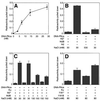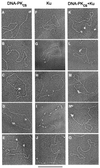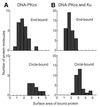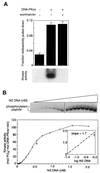Synapsis of DNA ends by DNA-dependent protein kinase
- PMID: 12065431
- PMCID: PMC126055
- DOI: 10.1093/emboj/cdf299
Synapsis of DNA ends by DNA-dependent protein kinase
Abstract
The catalytic subunit of DNA-dependent protein kinase (DNA-PK(CS)) is required for a non-homologous end-joining pathway that repairs DNA double-strand breaks produced by ionizing radiation or V(D)J recombination; however, its role in this pathway has remained obscure. Using a neutravidin pull-down assay, we found that DNA-PK(CS) mediates formation of a synaptic complex containing two DNA molecules. Furthermore, kinase activity was cooperative with respect to DNA concentration, suggesting that activation of the kinase occurs only after DNA synapsis. Electron microscopy revealed complexes of two DNA ends brought together by two DNA-PK(CS) molecules. Our results suggest that DNA-PK(CS) brings DNA ends together and then undergoes activation of its kinase, presumably to regulate subsequent steps for processing and ligation of the ends.
Figures






References
-
- Anderson C.W. and Lees-Miller,S.P. (1992) The nuclear serine/threonine protein kinase DNA-PK. Crit. Rev. Eukaryot. Gene Expr., 2, 283–314. - PubMed
-
- Chan D.W. and Lees-Miller,S.P. (1996) The DNA-dependent protein kinase is inactivated by autophosphorylation of the catalytic subunit. J. Biol. Chem., 271, 8936–8941. - PubMed
Publication types
MeSH terms
Substances
Grants and funding
LinkOut - more resources
Full Text Sources
Other Literature Sources
Molecular Biology Databases
Research Materials
Miscellaneous

